Gingin
Member
Hello,
I tested quite a lot the FDO MFD made by Indy
https://www.orbiter-forum.com/showthread.php?t=40471
Very nice MFD, reflecting some of the tools that Flight Dynamic Officers had to elaborate Shuttle Flight Plan.
A quick sum up of how strong it might be to reproduce with a great accuracy real mission.
Here, we gonna talk about STS-130, Launched Monday 8 Feb 2010 at 14h06 UTC.
Rendez vous on Flight Day 3, around MET 1/19:30 for Docking
ISS was at this epoch on a 188 x 183 orbit
It was the last Night Launch of STS programm
https://en.wikipedia.org/wiki/STS-130
For that first try, I used Spherical Gravity, with a launch window 300 seconds before the descending node to be almost in plane as there will be no nodal precession.
Endeavour on the Launch Pad

ISS waiting for her,

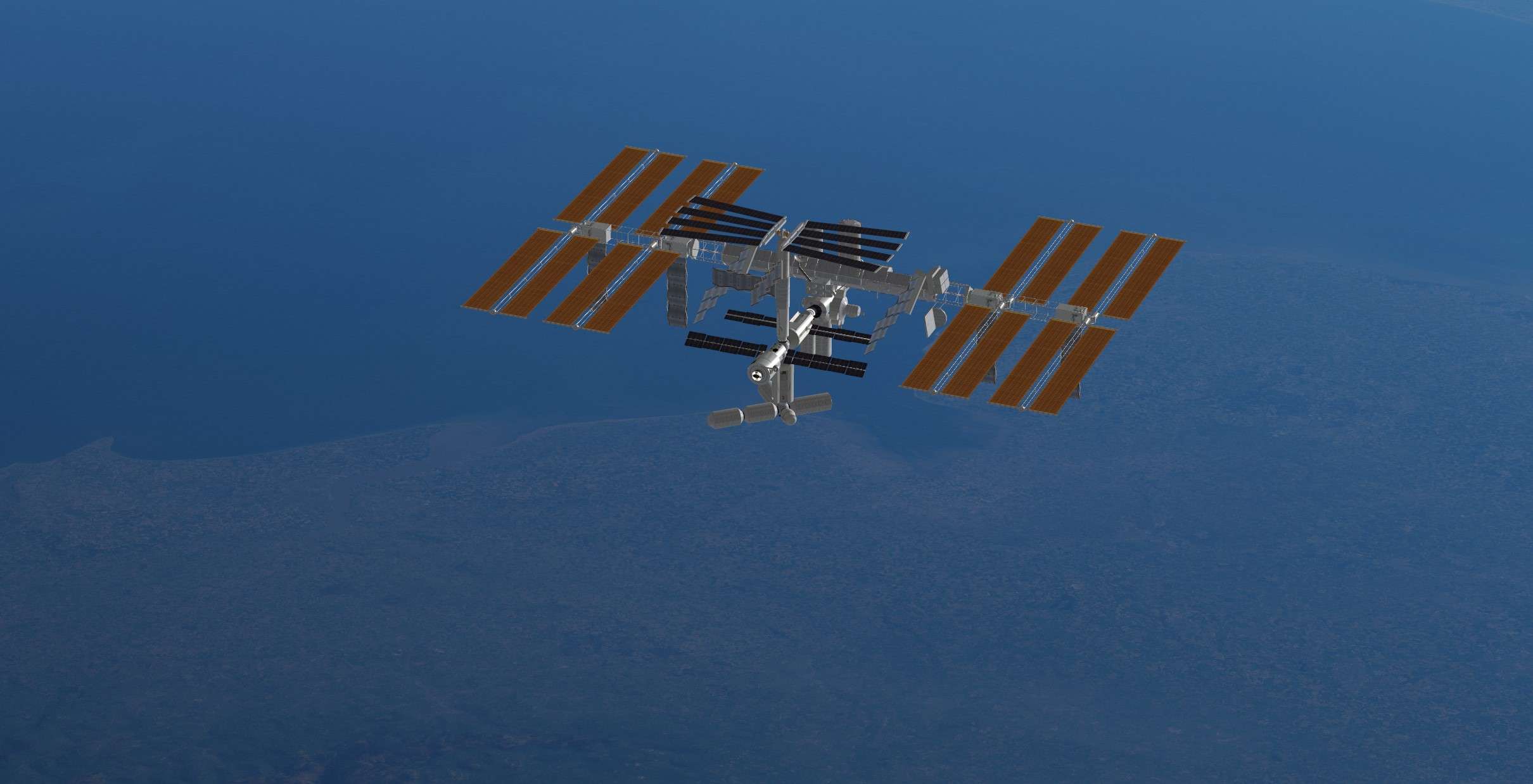
Lift off, Endeavour in roll programm

MECO time, Dump of propellant that will add around 10 fps of velocity.
Direct insertion Orbit of 124 Nm by 31 Nm
Apogee in 25 mn
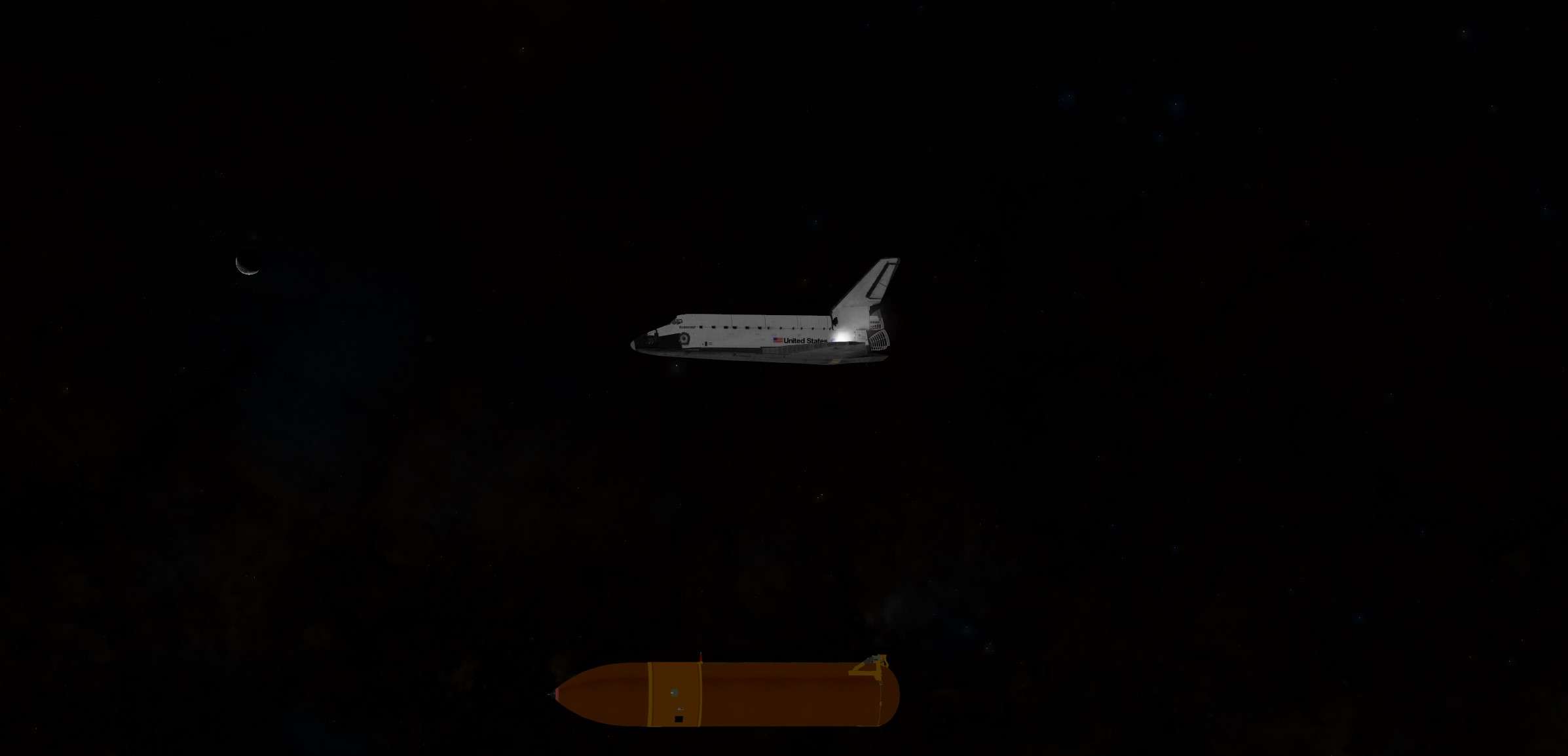
MET 0/0:36
OMS 2 burn was done at MET 0:0:37 mn ( 38:35 in real), for an Orbit of 124 Nm by 110 Nm
Over Saudi Arabia with Sinai and Aden golf, pretty impressive details on the ground
90 ° behind ISS ( 91 ° ish in real) after OMS-2
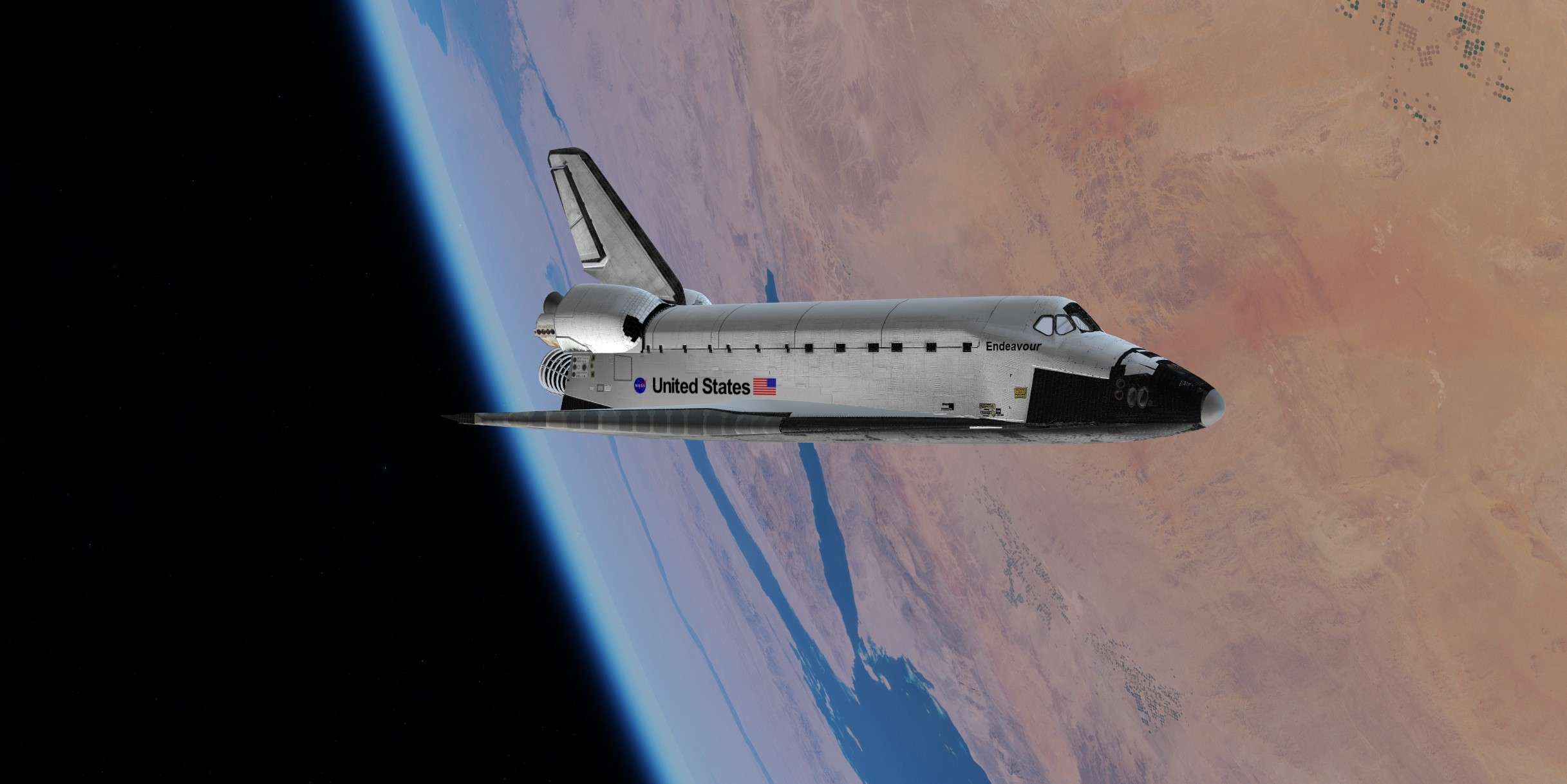
Alright, time to fire the FDO MFD and planify the rest of our Journey
Two important documents
First one, the forecasted Nasa flight plan for a Monday Launch

Second one, the real flight plan flown ( both of them are really close)
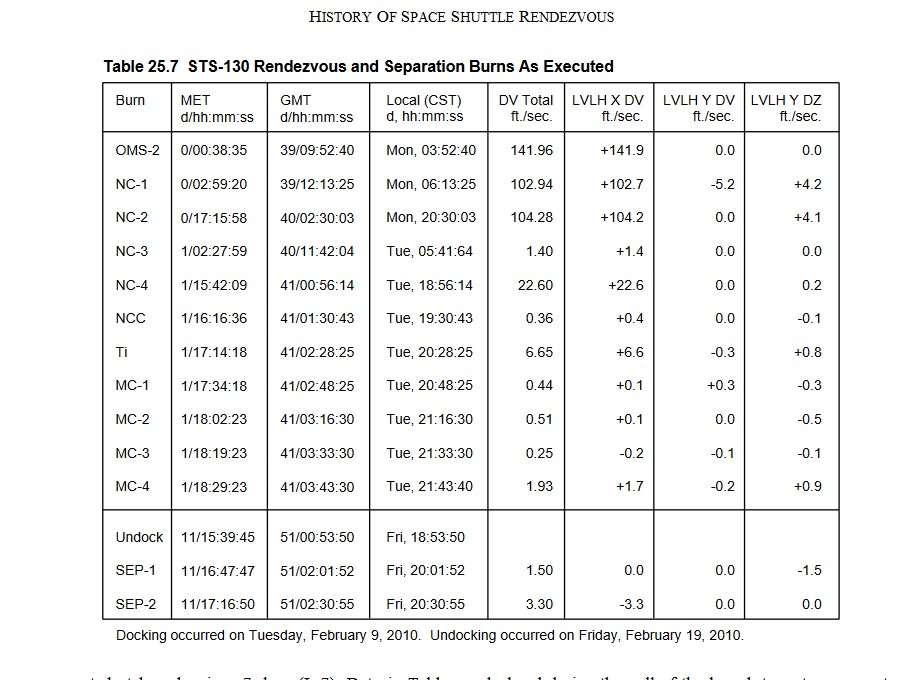
And here what we have after a bit of FDO preparation, trying to match the NASA Flight plan
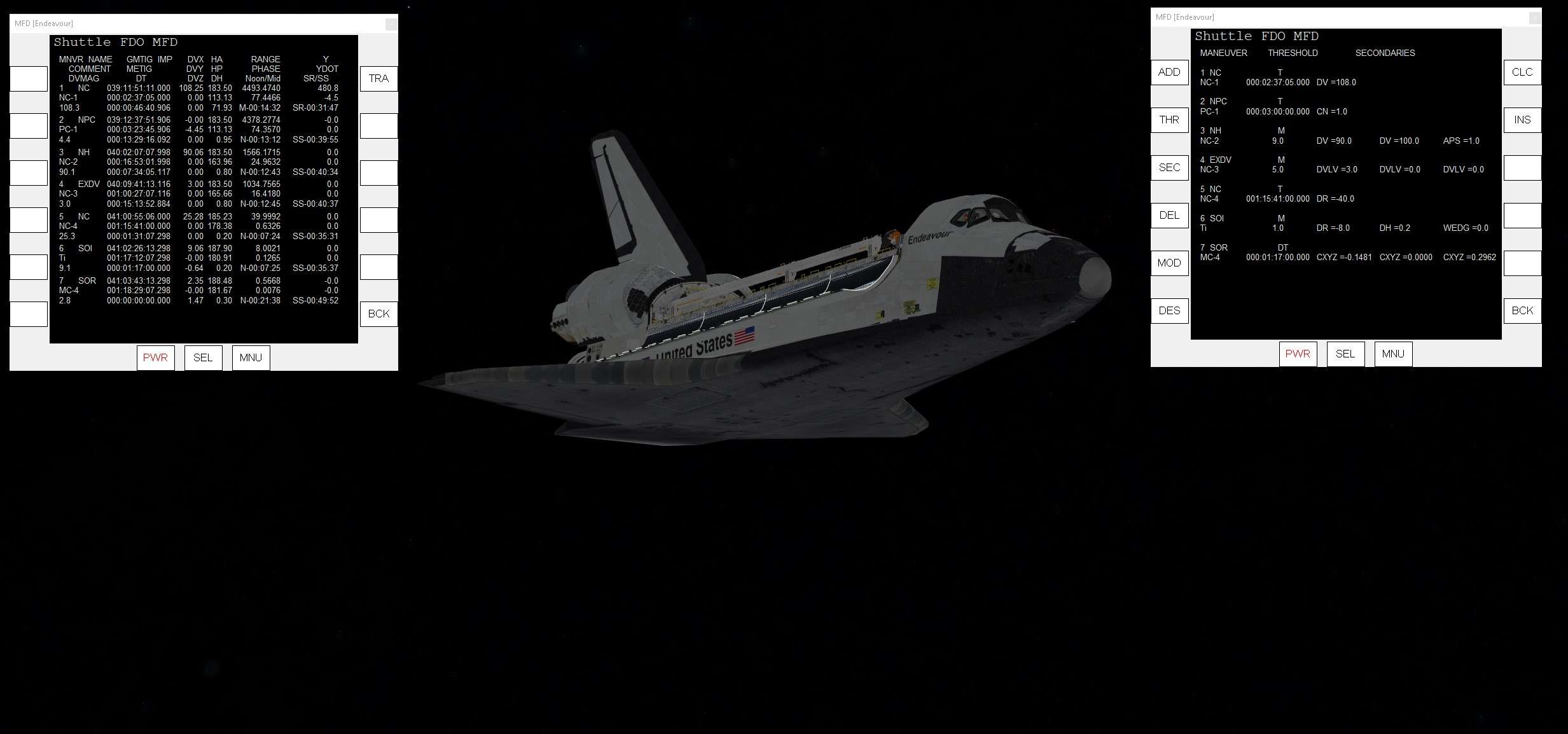
One phasing burn ( NC-1), on plane change burn ( NPC). Value is real small, Rinc was 0.01 ° after insertion and with no nodal precession, it helps :lol:
Then an height Adjust manouveuer ( NH), quite early on in that Flight plan. A bit weird, as it acts also as a phasing burn .
Then a place holder phasing burn ( EXDV). It adds 3 fps in prograde direction. Those burns were forecasted to avoid over phasing at the end of the rendez vous. One or two by Flight days were done.
Then the NC-4 burn, initiation of the last part of rendez vous, with the constraint to be 40 Nm behind ISS at a given time
Met of 1:15:40 here for1:15:42 in the real FP, not bad
And finally, Stable Orbit Initiation ( Ti) and Rendez Vous ( Mc 4) to finish the rendez vous plan.
Also, we can note that the lighting constraints at Ti ( Sunset minus 36 mn ) are respected.
It was important for a good visual on ISS before the MC 3 burn and to allow some Star tracker pass during last orbit before Rendez Vous.
So, we are within 2 mn of the real one after almost two days in space, let's see how it goes practically now
MET 0/02:36
First phasing burn, NC-1
It will raise the Apogee at 184 Nm to reduce the catch up rate and adjust the phasing procedure
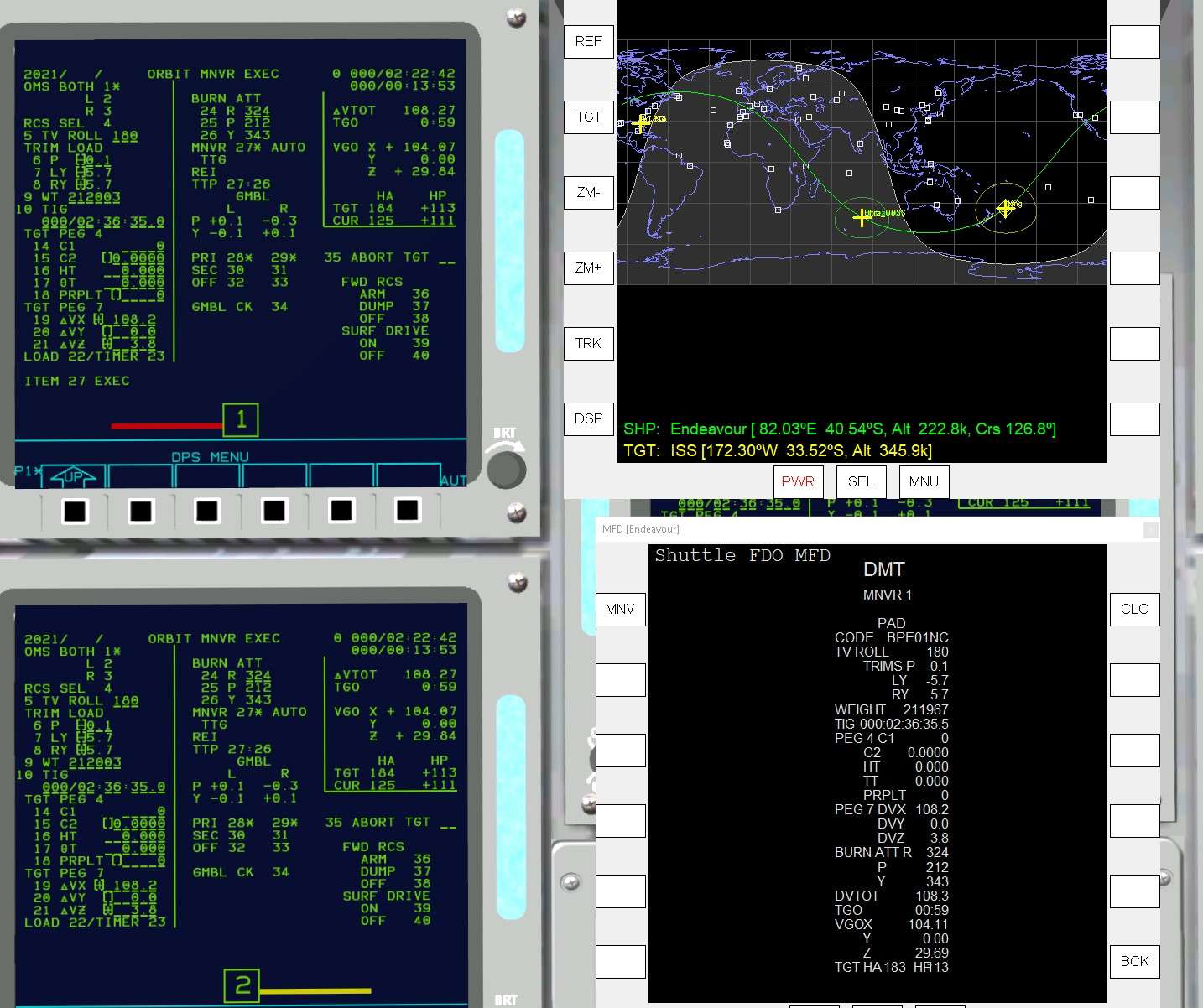
MET 0/3:23
NPC burn.
We will reduce to zero at a node our Relative Inclination and it will stay like that with Spherical Gravity parameter.
Note that if we activate Nodal Precession and Non spherical gravity, we have to Launch with an Eastward difference in LAN ( by some 0.15 °) to be in plane with a small NPC burn the day of rendez vous, as the LAN will drift westward faster for the Shuttle ( lower orbit) than ISS.
That is fascinating to plan those thing.
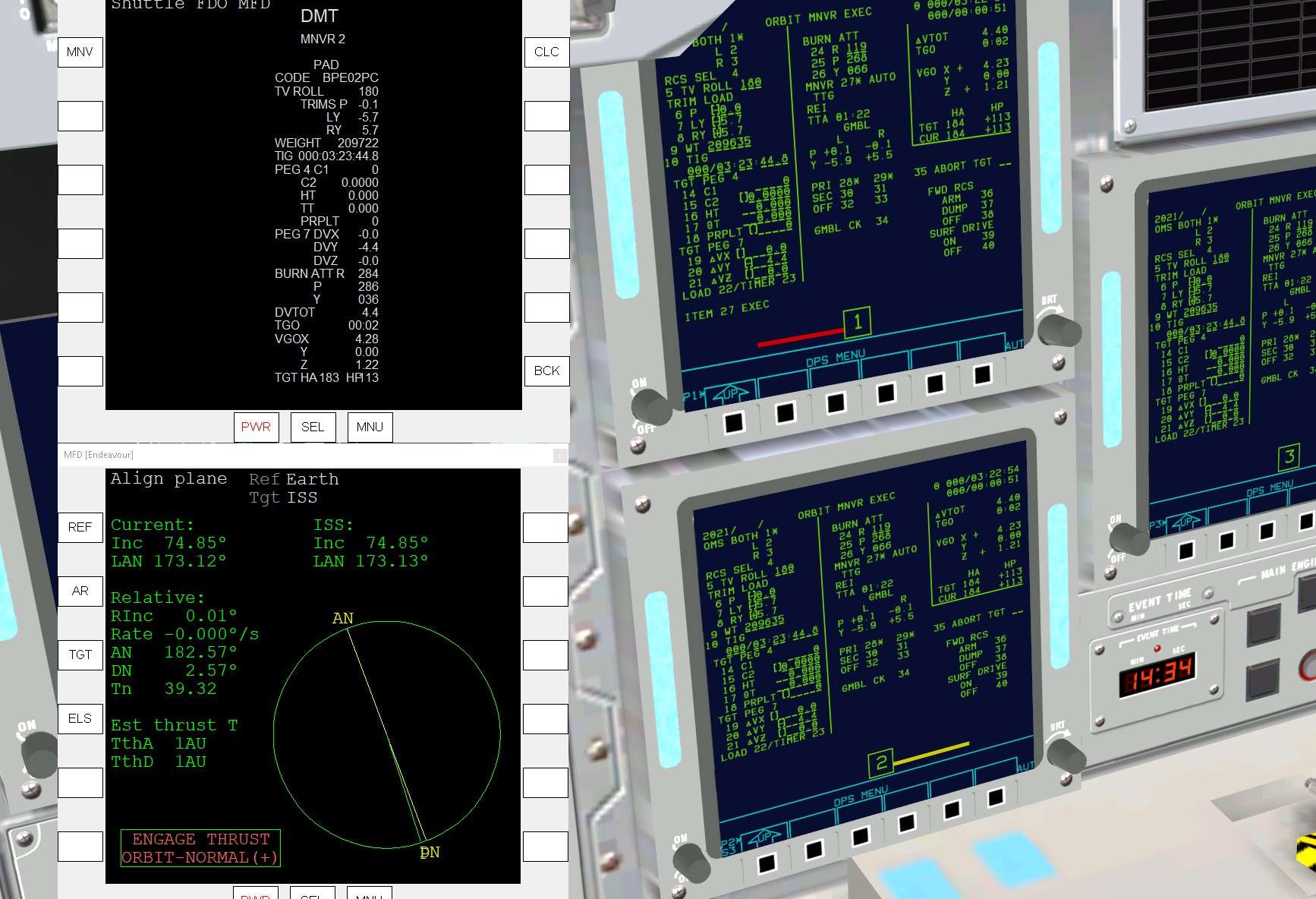
Overhead Marocco and Gibraltar

Hypnotic desert
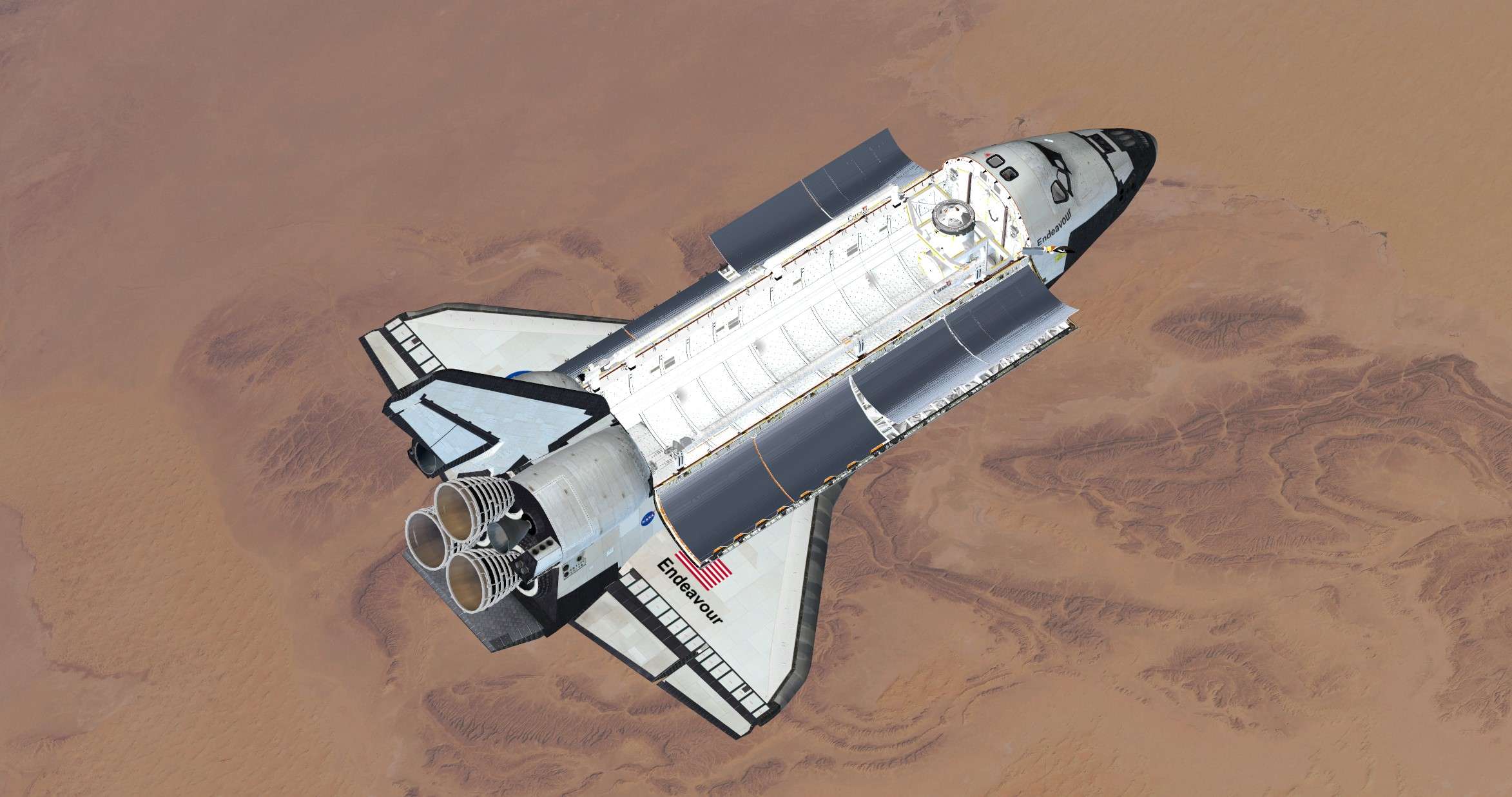
MET 0/16:52
NC-2 burn ( NH) to adjust the height of the Perigee. I will goes from 113 to 164 Nm.
Catching rate further reduced with that burn.
Rendez vous in one day ( like we said, really early NH burn for that mission)
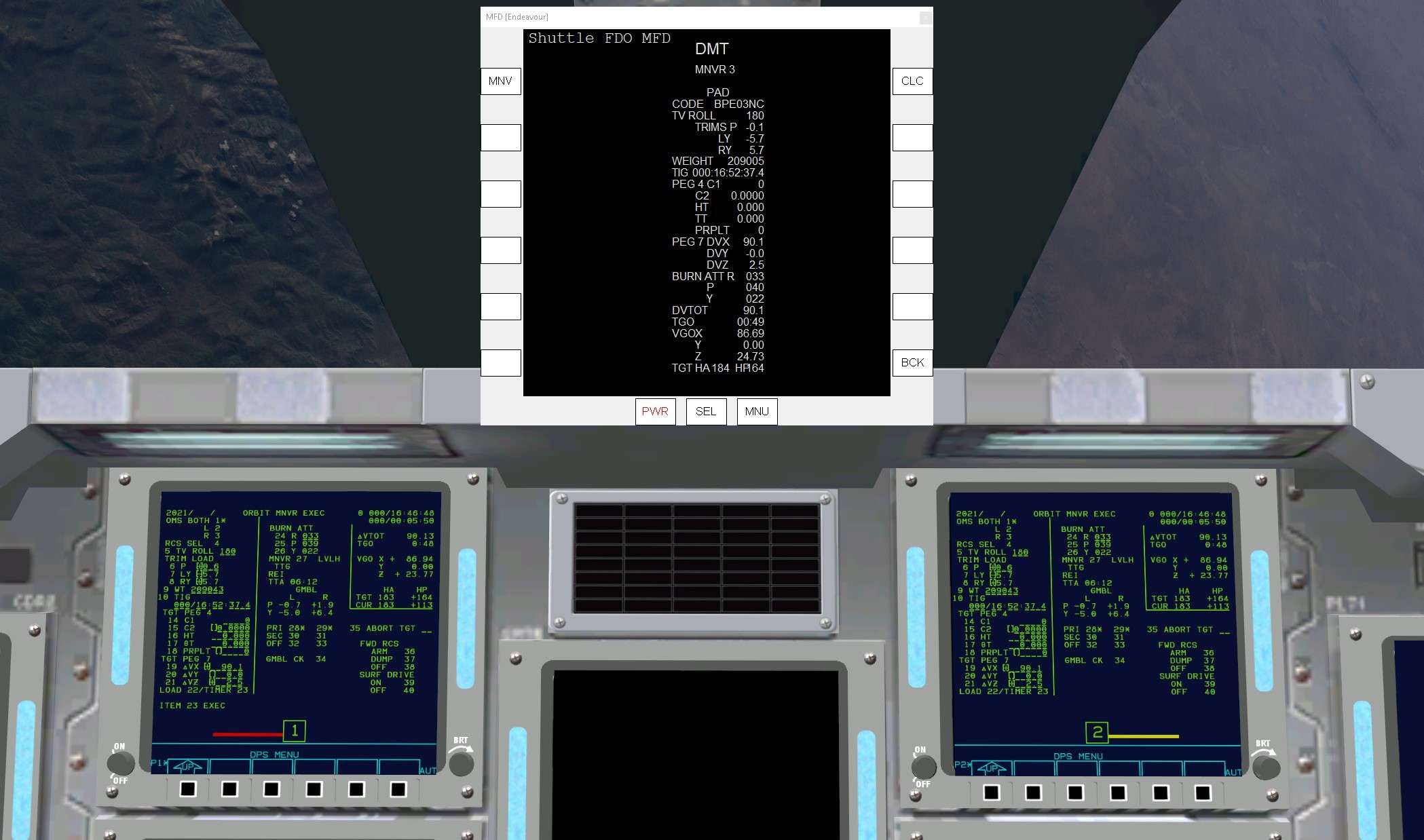
Canada in Background during the burn, leaving it for Atlantic Ocean
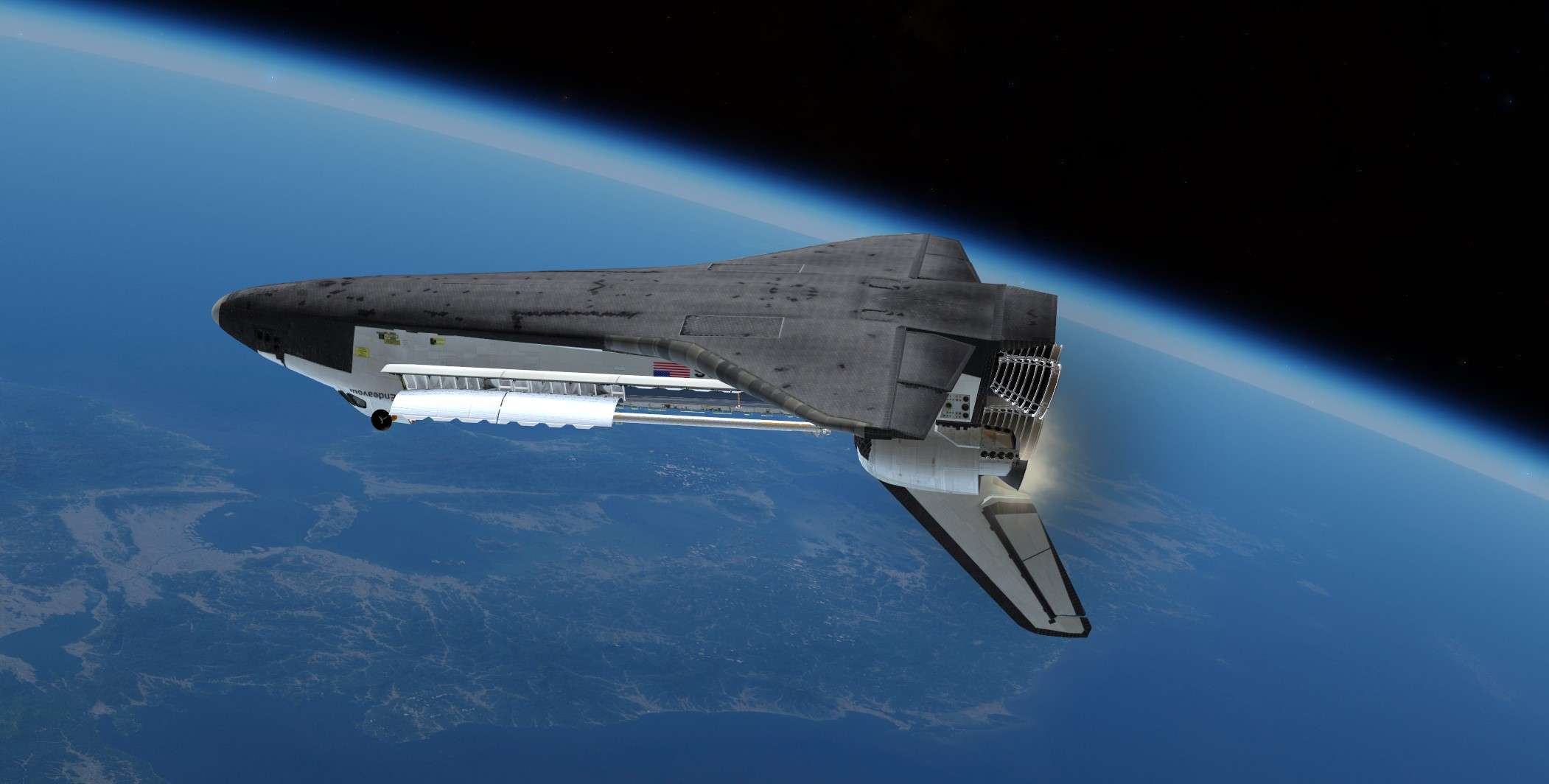
Post NH and EXDV burns ( 3 fps) parameters, looking good.
Phase of 25 °, 2900 km behing the lady. Close to FP
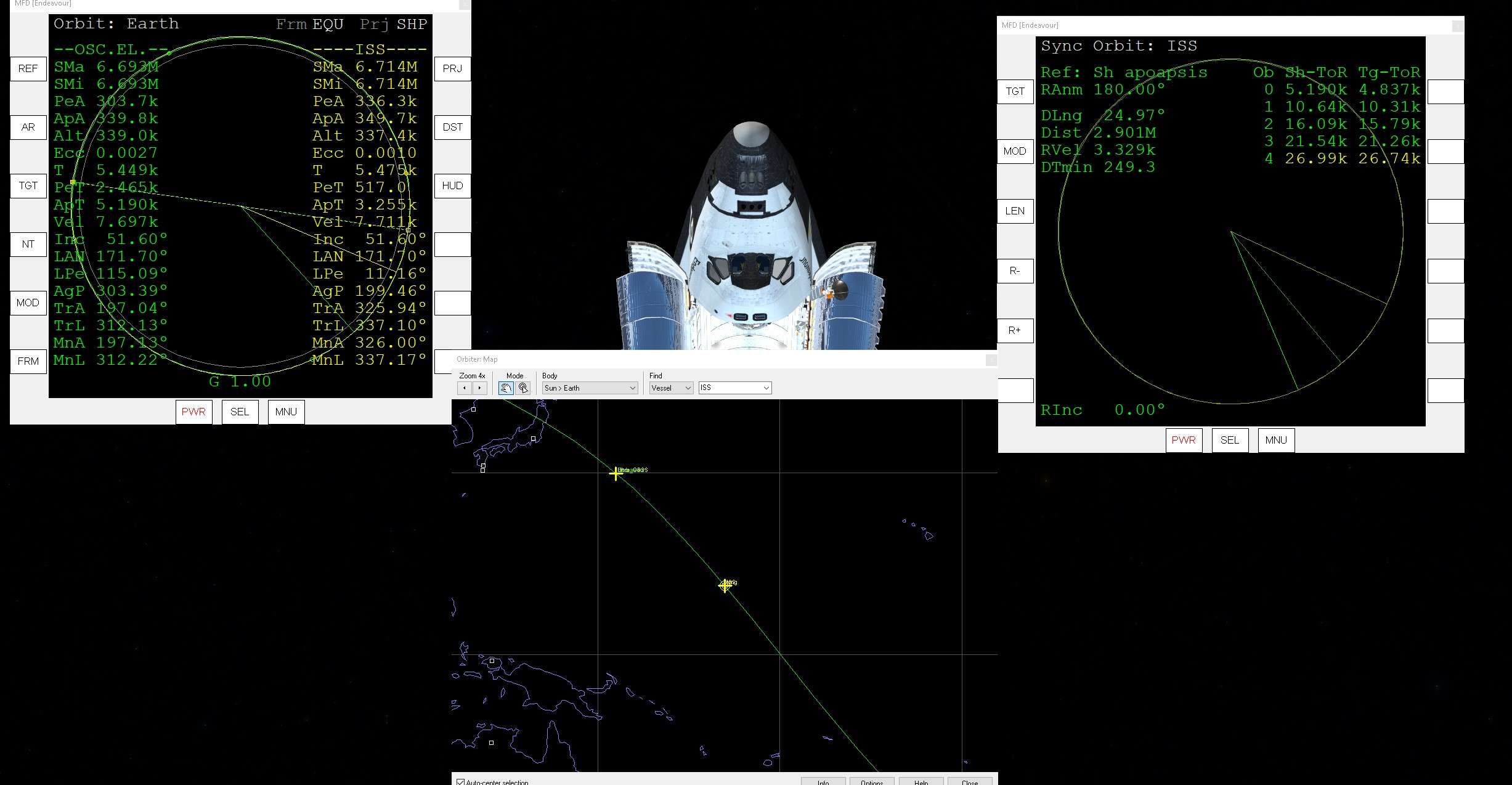
Alright, time now for the last part of rendez vous starting at NC-4 burn
Rendez vous in two orbits from now on
A quick recap on what we want to fly and where we want to be as per NASA procedure
Two relative motion plot, first one from NASA, second one made by hand for STS 88 with the distance in Kfeet and Km for a better situational awareness
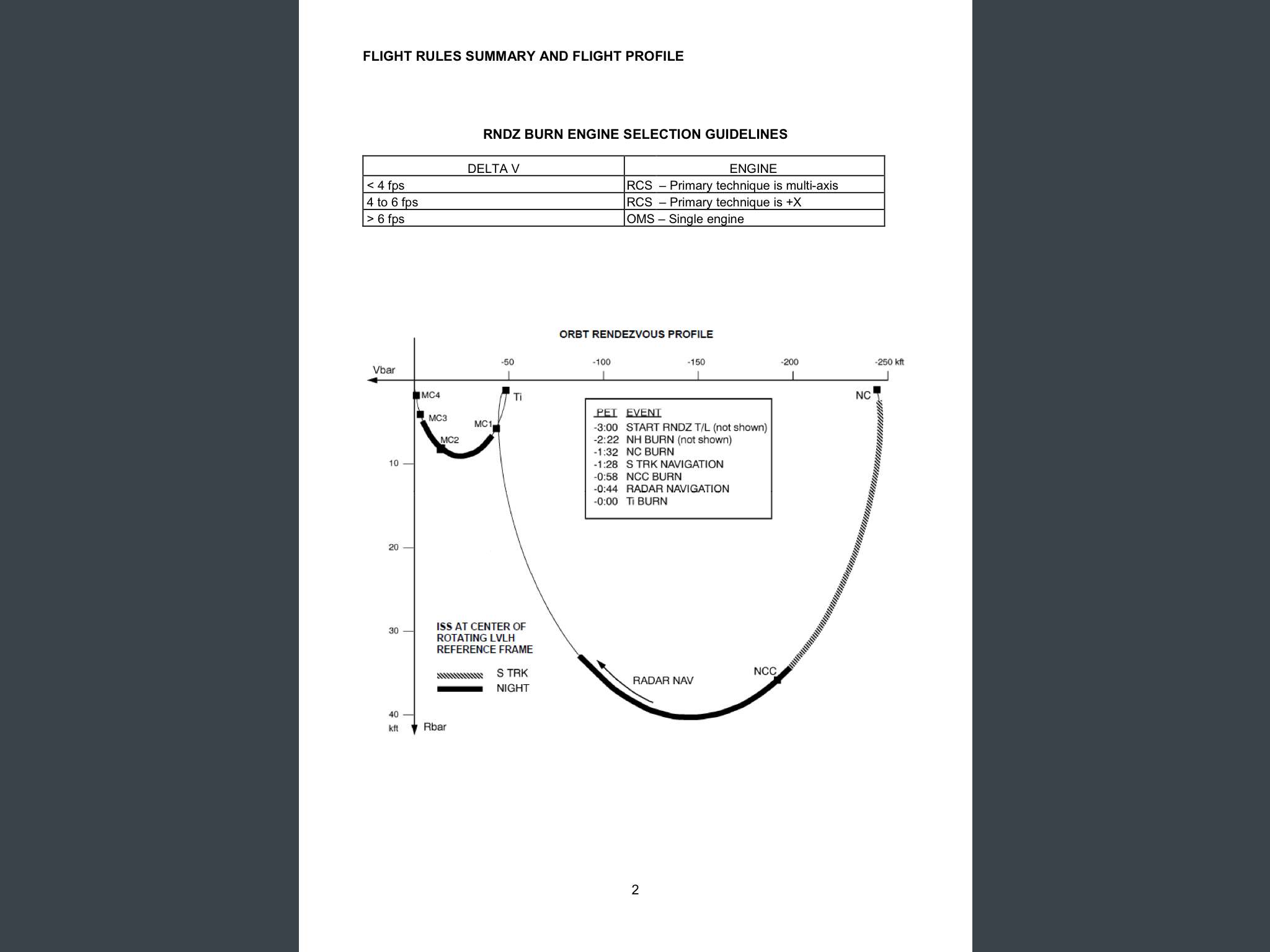

MET 01/15:41
Final Phasing burn NC-4
We wanted to be 40 Nm behind ISS ( 250 Kfeet/ 76.2 km)
We are 75.87 km behind, sweet
It will raise the perigee to 178 Nm to be one orbit Later in good conditions for Ti burn

Let's fire the ergols

MET 01/16:14
Time now for the first Lambert targeted Burn using Spec 34
It is called NCC ( Corrective Combination Burn)
It is named like that because it is a burn on all three axis ( X Y Z) that will affinate our Ti position 57.7 mn later on
Some explanations on that tool
It used Lambert equations, which allows to add time in the equation.
We are at a relative position at time T1 and we want to be in a finite amount of time ( DT) at a specific relative position at T2 regarding the target ( Delta X for downrange, Delta Y for crossrange, Delta Z for Height in kfeet)
T1 TIG: Time of when we want to make a burn ( red)
DX ( downrange), Dz ( height), DY ( cross range) will be the relative position of the Shuttle compared to ISS at Time of Ignition ( in kilo feet)
Dx dot etc will be the relative speed at TIG
Not yet implemented in SSU
T2 TIG is the time where we want to be at a specific position relative to ISS
That position is define below with DX,y z. ( blue)
For example, we can say to the computer : I want to do a burn at T1 07:00, I want to be in one hour T2 08:00 at ISS position, 10 kfeet below ( Dx=0, Dy=0, Dz= +10)
Then Item 28 compute T1 will try to give us a solution in LVLH frame that we can read at the top of the Spec 34 display ( DVX,y,z), automatically transfered to OPS 202 for the burn (Pink)
Ti timing is one orbit after the NC burn we made, so around MET 1/17:12
We want to burn 57.7 mn earlier for NCC, hence the T1 at 1/16:14:18
Dt of 57.7 mn
Dx -48.60 ( 48600 feet/ 8nm behind ISS at Ti)
Dy 0 ( no cross range)
Dz 1.20 ( 1200 feet below her at Ti)
Result is a small burn of 3.4 total velocity, thanks to the good phasing done by FDO Mfd
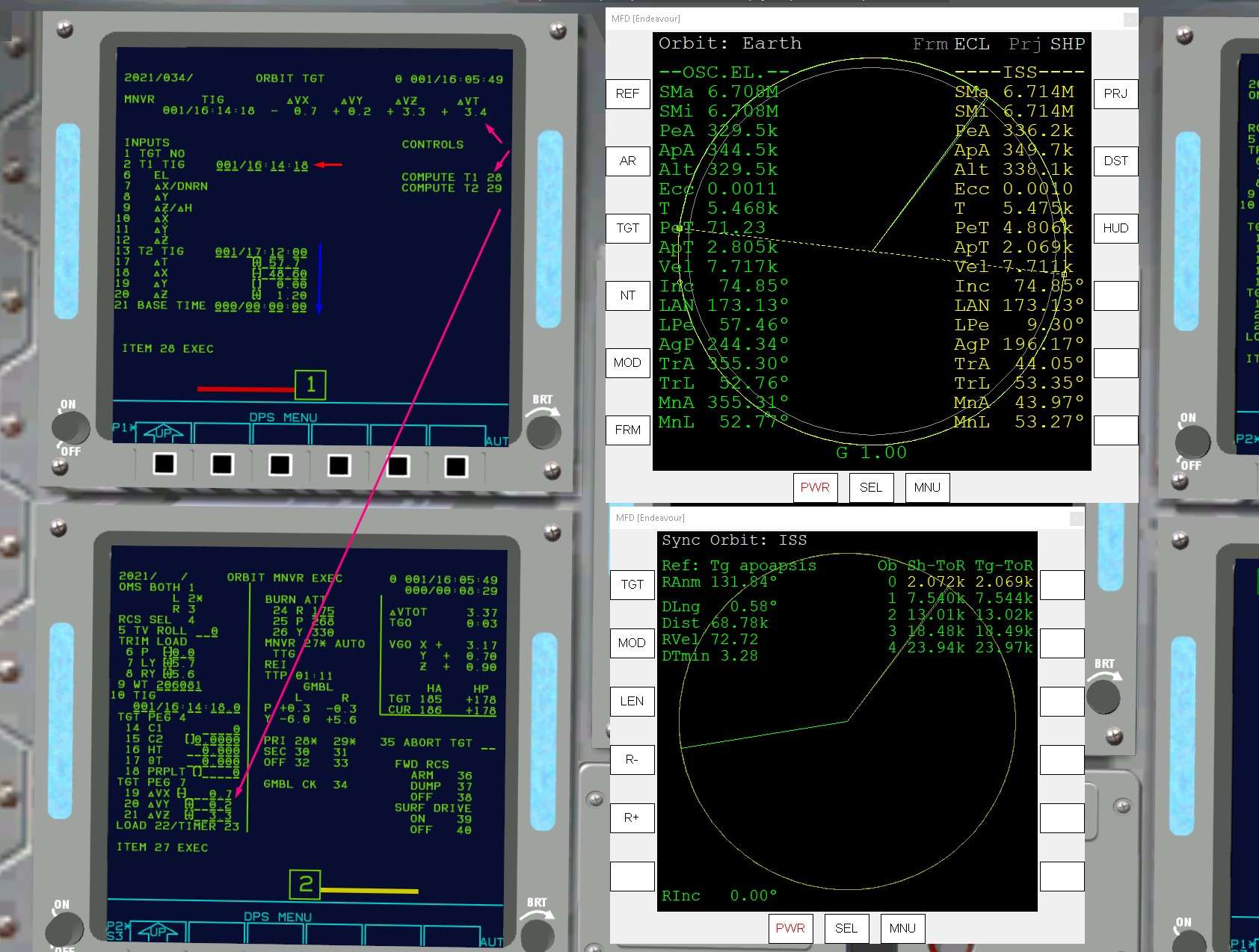
One engine burn for small DV

MET 01/17:12
Ti burn now, Stable Orbit Initiation Burn
We target the MC-4 burn here, 76.9 mn later where we want to be 900 feet behind ISS and 1800 feet below
You can notice that value are really close to FDO and real FP one
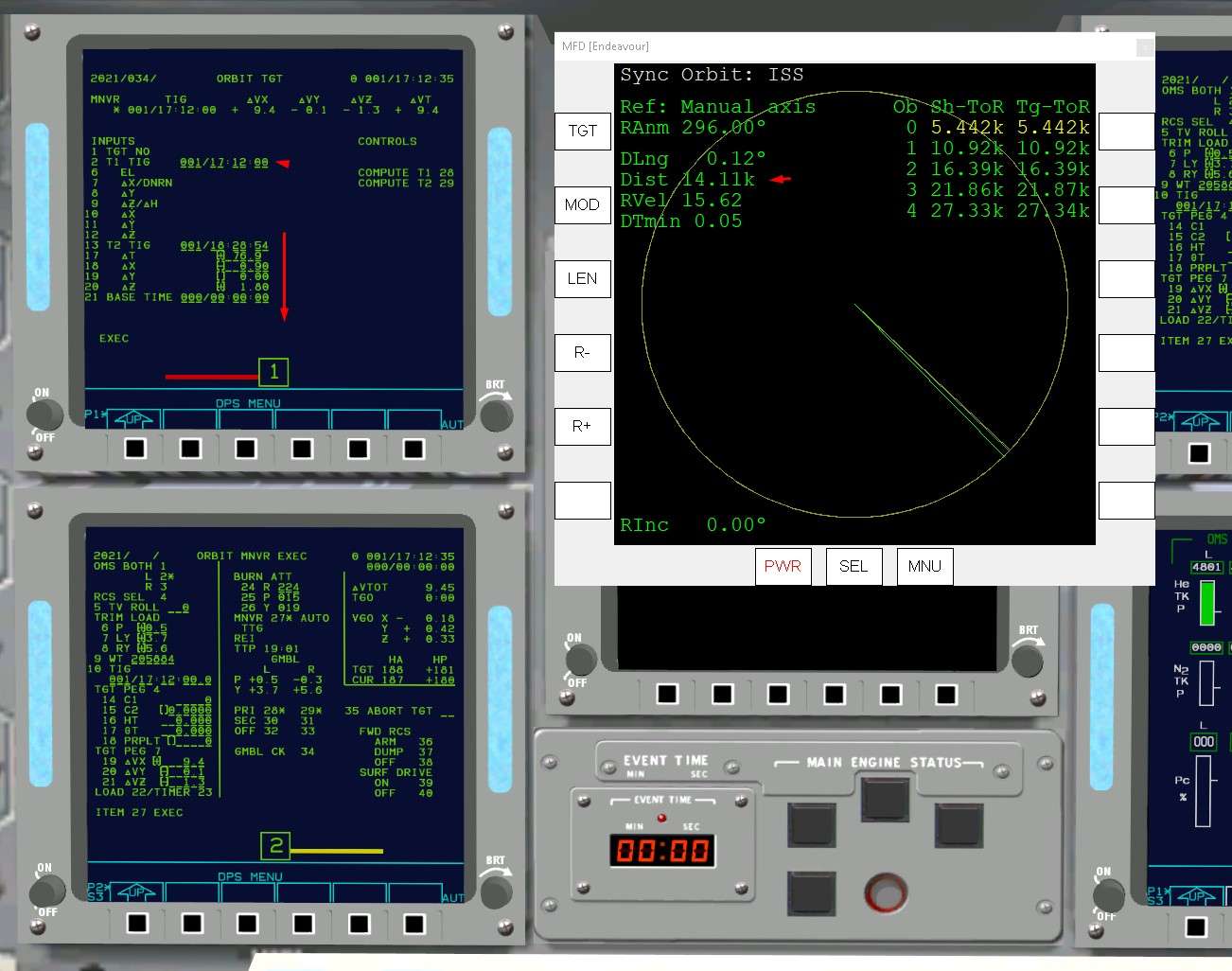
Thanks to the good sunlight condition ( 36 mn before sunset), we already have a good visuel on ISS
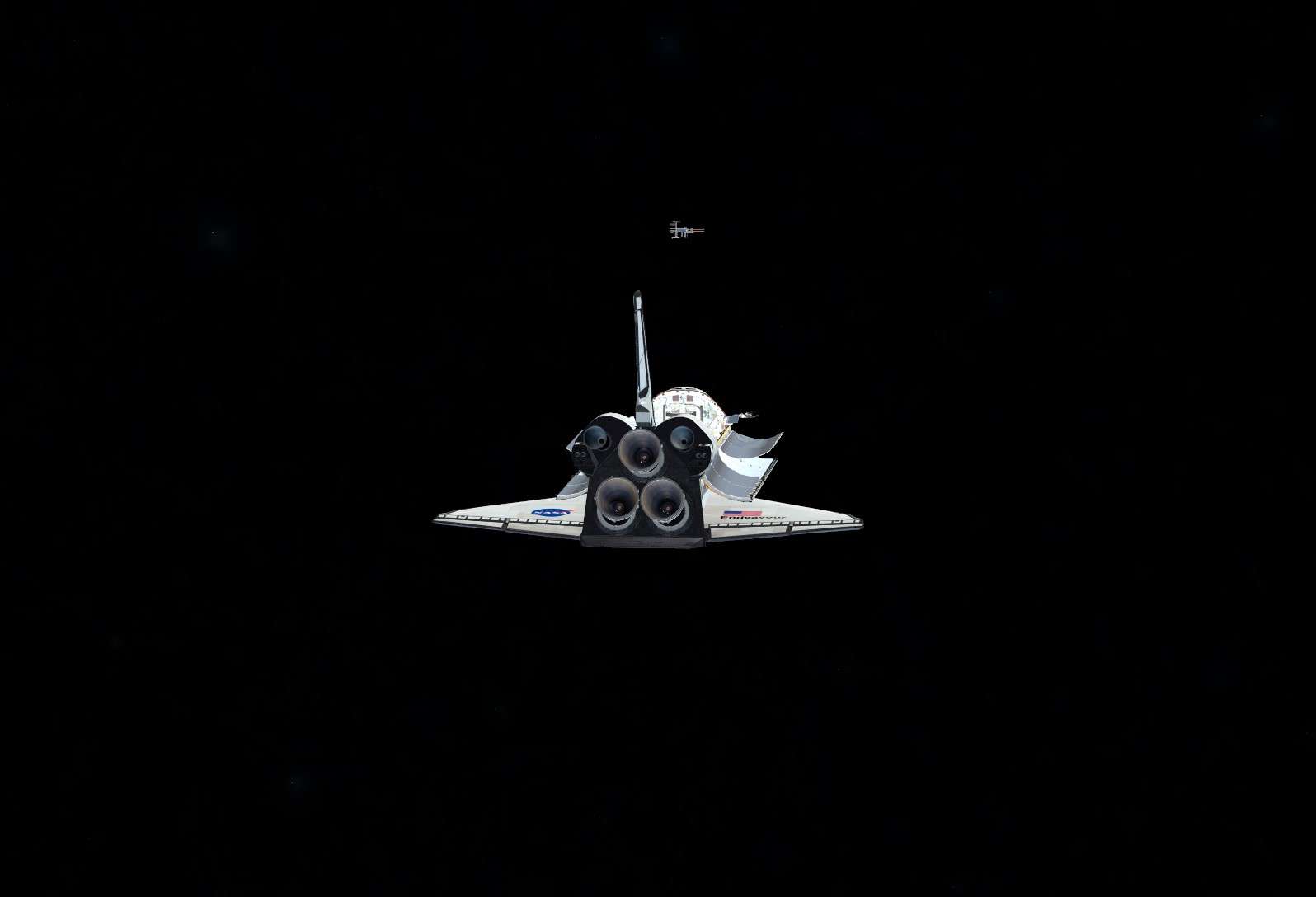
Last orbit before rendez vous, with a couple of Mid course correction
Mid course correction
First one 20 mn after ti burn
We change the T1 and the DT to let the T2 ( 01:18:28 MC 4 target) the same
MC-1 very small ( 0.5 fps)
Multi axis correction, just some RCS firing in Translation mode to null the VGO on X Y and Z shuttle body axes

MC-2 correction, 50 mn after Ti
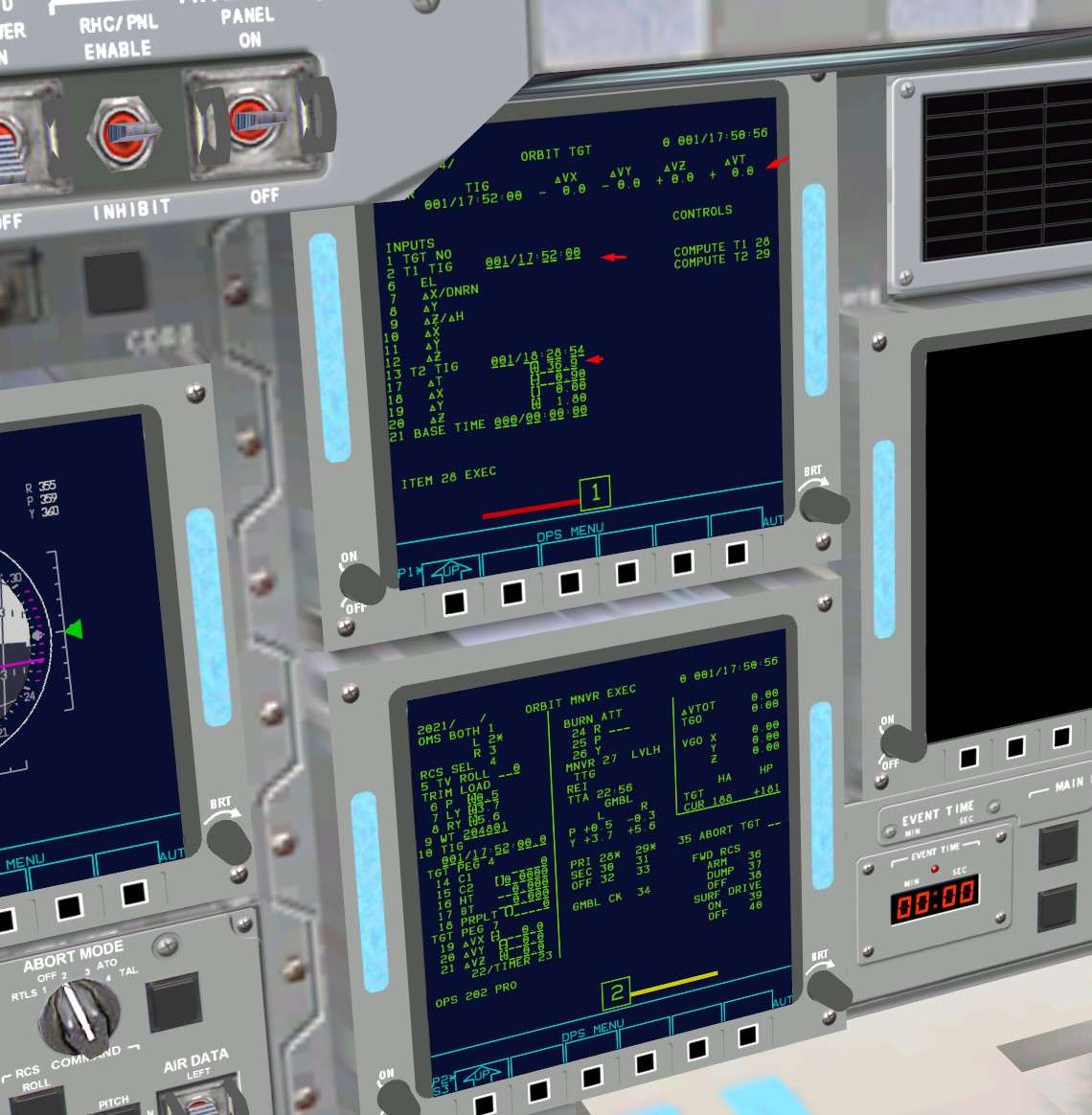
MC-3 correction, 67 mn after Ti
1 fps of correction, really low

MET 01/18:28:54
MC 4 correction, Stable Orbit Rendez Vous burn.
We are at less than 2000 feet from ISS.
That burn will target a stable R bar position in 13 mn , 600 feet behind ISS
In real, it happened at MET 01/18:29:23
Look how close we are from real timeline ( half a minute)
I forgot to take a pic, I took the one from STS 88 just to see the D x y z paramaters


Arriving at R bar position with natural breaking.
We are a tad lower than ISS, so Shuttle will have a tendency to fall down.
Hence the need to fire +Z translation thrusters ( it avoid plume from -Z thrusters)
600feet below, less than 1 fps of relatice speed.
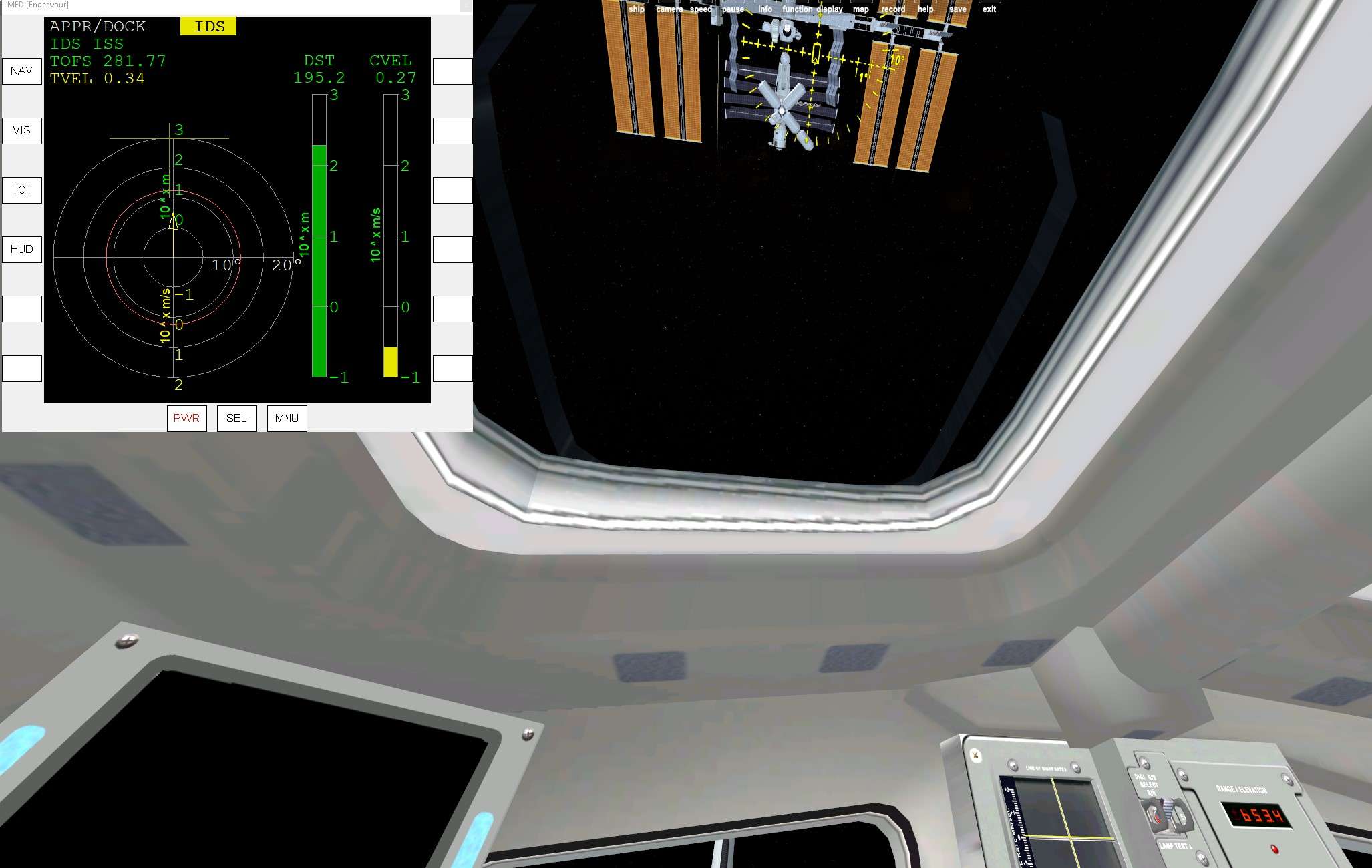
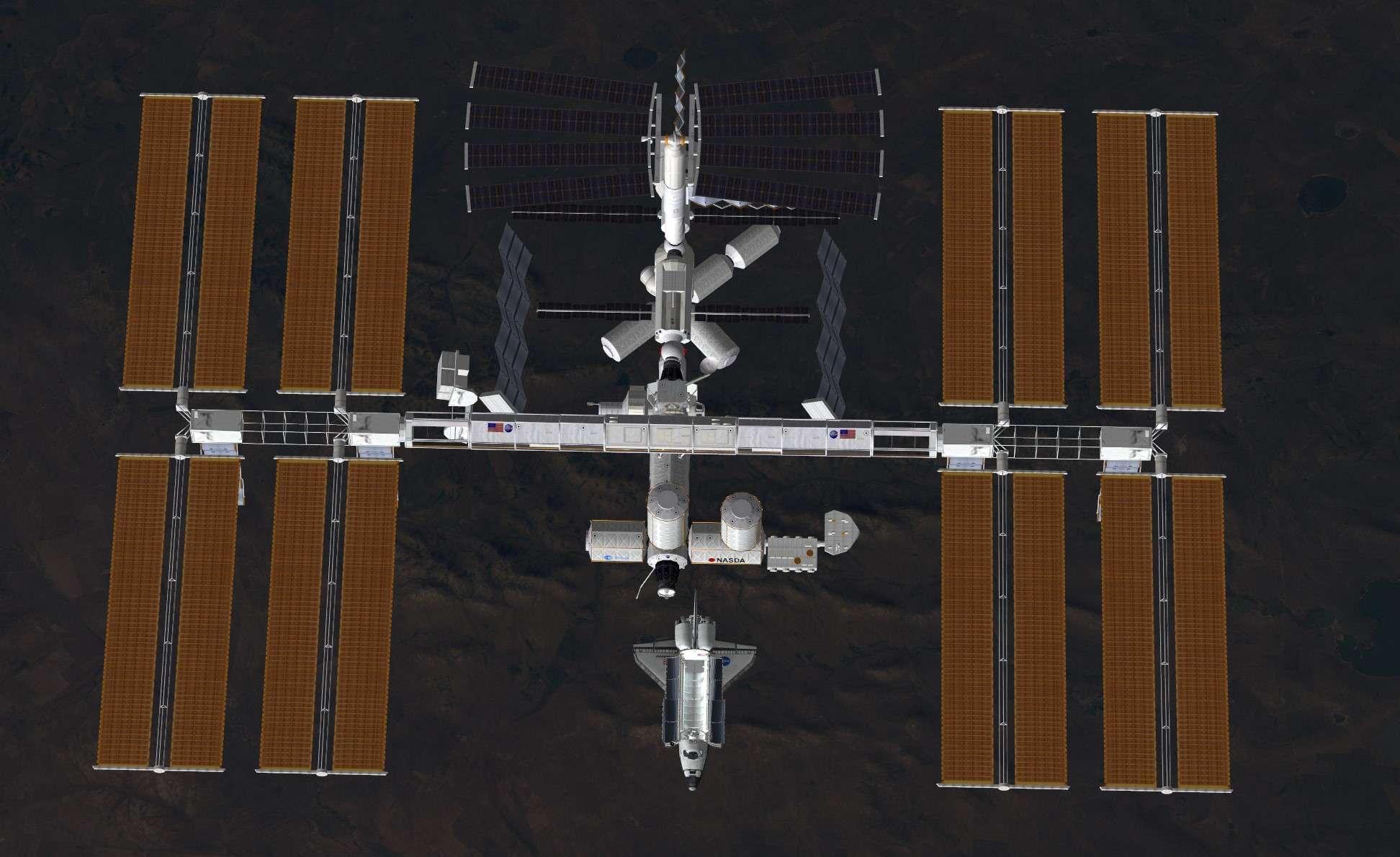
Then V bar transition

And Docking on time for Endeavour, with good sunlight conditions
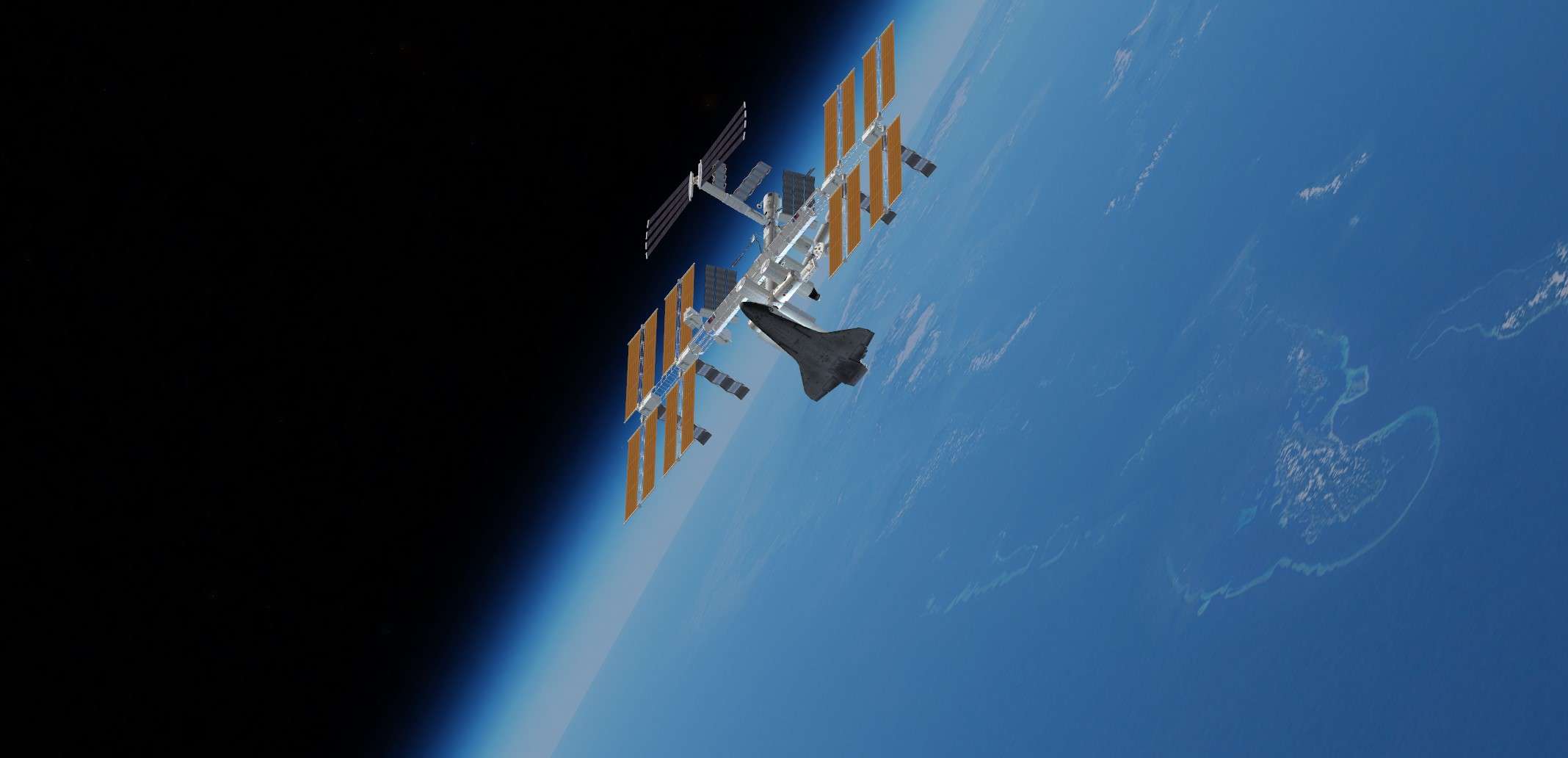
I ran out of Forward RCS prop, always to impatient for the final phase of docking which is quite long in real and slow.
Really impressed by the FDO tools.
Great help, great accuracy.
It is feasible to do it by hand for rendez vous, but not with that timeline precision for Sun conditions particularly
Great job Indy
I tested quite a lot the FDO MFD made by Indy
https://www.orbiter-forum.com/showthread.php?t=40471
Very nice MFD, reflecting some of the tools that Flight Dynamic Officers had to elaborate Shuttle Flight Plan.
A quick sum up of how strong it might be to reproduce with a great accuracy real mission.
Here, we gonna talk about STS-130, Launched Monday 8 Feb 2010 at 14h06 UTC.
Rendez vous on Flight Day 3, around MET 1/19:30 for Docking
ISS was at this epoch on a 188 x 183 orbit
It was the last Night Launch of STS programm
https://en.wikipedia.org/wiki/STS-130
For that first try, I used Spherical Gravity, with a launch window 300 seconds before the descending node to be almost in plane as there will be no nodal precession.
Endeavour on the Launch Pad

ISS waiting for her,


Lift off, Endeavour in roll programm

MECO time, Dump of propellant that will add around 10 fps of velocity.
Direct insertion Orbit of 124 Nm by 31 Nm
Apogee in 25 mn

MET 0/0:36
OMS 2 burn was done at MET 0:0:37 mn ( 38:35 in real), for an Orbit of 124 Nm by 110 Nm
Over Saudi Arabia with Sinai and Aden golf, pretty impressive details on the ground
90 ° behind ISS ( 91 ° ish in real) after OMS-2

Alright, time to fire the FDO MFD and planify the rest of our Journey
Two important documents
First one, the forecasted Nasa flight plan for a Monday Launch

Second one, the real flight plan flown ( both of them are really close)

And here what we have after a bit of FDO preparation, trying to match the NASA Flight plan

One phasing burn ( NC-1), on plane change burn ( NPC). Value is real small, Rinc was 0.01 ° after insertion and with no nodal precession, it helps :lol:
Then an height Adjust manouveuer ( NH), quite early on in that Flight plan. A bit weird, as it acts also as a phasing burn .
Then a place holder phasing burn ( EXDV). It adds 3 fps in prograde direction. Those burns were forecasted to avoid over phasing at the end of the rendez vous. One or two by Flight days were done.
Then the NC-4 burn, initiation of the last part of rendez vous, with the constraint to be 40 Nm behind ISS at a given time
Met of 1:15:40 here for1:15:42 in the real FP, not bad
And finally, Stable Orbit Initiation ( Ti) and Rendez Vous ( Mc 4) to finish the rendez vous plan.
Also, we can note that the lighting constraints at Ti ( Sunset minus 36 mn ) are respected.
It was important for a good visual on ISS before the MC 3 burn and to allow some Star tracker pass during last orbit before Rendez Vous.
So, we are within 2 mn of the real one after almost two days in space, let's see how it goes practically now
MET 0/02:36
First phasing burn, NC-1
It will raise the Apogee at 184 Nm to reduce the catch up rate and adjust the phasing procedure

MET 0/3:23
NPC burn.
We will reduce to zero at a node our Relative Inclination and it will stay like that with Spherical Gravity parameter.
Note that if we activate Nodal Precession and Non spherical gravity, we have to Launch with an Eastward difference in LAN ( by some 0.15 °) to be in plane with a small NPC burn the day of rendez vous, as the LAN will drift westward faster for the Shuttle ( lower orbit) than ISS.
That is fascinating to plan those thing.

Overhead Marocco and Gibraltar

Hypnotic desert

MET 0/16:52
NC-2 burn ( NH) to adjust the height of the Perigee. I will goes from 113 to 164 Nm.
Catching rate further reduced with that burn.
Rendez vous in one day ( like we said, really early NH burn for that mission)

Canada in Background during the burn, leaving it for Atlantic Ocean

Post NH and EXDV burns ( 3 fps) parameters, looking good.
Phase of 25 °, 2900 km behing the lady. Close to FP

Alright, time now for the last part of rendez vous starting at NC-4 burn
Rendez vous in two orbits from now on
A quick recap on what we want to fly and where we want to be as per NASA procedure
Two relative motion plot, first one from NASA, second one made by hand for STS 88 with the distance in Kfeet and Km for a better situational awareness


MET 01/15:41
Final Phasing burn NC-4
We wanted to be 40 Nm behind ISS ( 250 Kfeet/ 76.2 km)
We are 75.87 km behind, sweet
It will raise the perigee to 178 Nm to be one orbit Later in good conditions for Ti burn

Let's fire the ergols

MET 01/16:14
Time now for the first Lambert targeted Burn using Spec 34
It is called NCC ( Corrective Combination Burn)
It is named like that because it is a burn on all three axis ( X Y Z) that will affinate our Ti position 57.7 mn later on
Some explanations on that tool
It used Lambert equations, which allows to add time in the equation.
We are at a relative position at time T1 and we want to be in a finite amount of time ( DT) at a specific relative position at T2 regarding the target ( Delta X for downrange, Delta Y for crossrange, Delta Z for Height in kfeet)
T1 TIG: Time of when we want to make a burn ( red)
DX ( downrange), Dz ( height), DY ( cross range) will be the relative position of the Shuttle compared to ISS at Time of Ignition ( in kilo feet)
Dx dot etc will be the relative speed at TIG
Not yet implemented in SSU
T2 TIG is the time where we want to be at a specific position relative to ISS
That position is define below with DX,y z. ( blue)
For example, we can say to the computer : I want to do a burn at T1 07:00, I want to be in one hour T2 08:00 at ISS position, 10 kfeet below ( Dx=0, Dy=0, Dz= +10)
Then Item 28 compute T1 will try to give us a solution in LVLH frame that we can read at the top of the Spec 34 display ( DVX,y,z), automatically transfered to OPS 202 for the burn (Pink)
Ti timing is one orbit after the NC burn we made, so around MET 1/17:12
We want to burn 57.7 mn earlier for NCC, hence the T1 at 1/16:14:18
Dt of 57.7 mn
Dx -48.60 ( 48600 feet/ 8nm behind ISS at Ti)
Dy 0 ( no cross range)
Dz 1.20 ( 1200 feet below her at Ti)
Result is a small burn of 3.4 total velocity, thanks to the good phasing done by FDO Mfd

One engine burn for small DV

MET 01/17:12
Ti burn now, Stable Orbit Initiation Burn
We target the MC-4 burn here, 76.9 mn later where we want to be 900 feet behind ISS and 1800 feet below
You can notice that value are really close to FDO and real FP one

Thanks to the good sunlight condition ( 36 mn before sunset), we already have a good visuel on ISS

Last orbit before rendez vous, with a couple of Mid course correction
Mid course correction
First one 20 mn after ti burn
We change the T1 and the DT to let the T2 ( 01:18:28 MC 4 target) the same
MC-1 very small ( 0.5 fps)
Multi axis correction, just some RCS firing in Translation mode to null the VGO on X Y and Z shuttle body axes

MC-2 correction, 50 mn after Ti

MC-3 correction, 67 mn after Ti
1 fps of correction, really low

MET 01/18:28:54
MC 4 correction, Stable Orbit Rendez Vous burn.
We are at less than 2000 feet from ISS.
That burn will target a stable R bar position in 13 mn , 600 feet behind ISS
In real, it happened at MET 01/18:29:23
Look how close we are from real timeline ( half a minute)
I forgot to take a pic, I took the one from STS 88 just to see the D x y z paramaters


Arriving at R bar position with natural breaking.
We are a tad lower than ISS, so Shuttle will have a tendency to fall down.
Hence the need to fire +Z translation thrusters ( it avoid plume from -Z thrusters)
600feet below, less than 1 fps of relatice speed.


Then V bar transition

And Docking on time for Endeavour, with good sunlight conditions

I ran out of Forward RCS prop, always to impatient for the final phase of docking which is quite long in real and slow.
Really impressed by the FDO tools.
Great help, great accuracy.
It is feasible to do it by hand for rendez vous, but not with that timeline precision for Sun conditions particularly
Great job Indy
Last edited:

 or HAL/S.... or in SSU, C++ (maybe with HAL/S like DSL)
or HAL/S.... or in SSU, C++ (maybe with HAL/S like DSL)